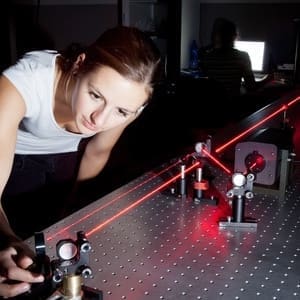In this post
All components that have a circuit offer some resistance. This is because each component resists the flow of electricity to a certain degree. The amount of resistance depends on the thickness or length of a wire in the component itself. The thicker the wire, the lower the resistance, and the longer the wire, the higher the resistance.
Electrical resistance is a measurement of the difficulty with which electricity can pass through any particular component of a circuit. Resistance is measured in ohms (Ω) and is dependent upon the size of the voltage acting across it and the current flowing through it. The relationship between these three factors is shown by the equation:
V = the potential difference and is measured in volts (V)
I = the current in amperes (A)
R = the resistance in ohms (Ω)
You must know and be able to rearrange this equation as it will not be provided in the exam.
This equation shows that at a constant resistance, there is a directly proportional relationship between voltage and current. As voltage increases, the current also increases. Increasing the voltage means that the electrons moving around the circuit are given a bigger ‘push’. They will move faster and a higher number of them then passes the same point every second. This increases the current.
The equation can then be rearranged to find the resistance:
Example
If 6A flows through a 900V kettle, what is the resistance of the kettle?
Remember, the resistance is the voltage (measured in volts), divided by the current (measured in amperes). We know that the voltage is 900V and that 6A of current is flowing through it. The equation we use is R = V ÷ I
The equation can also be rearranged to find the current in a circuit from given values of resistance and voltage as shown below:
As the equation shows, the current is dependent upon the size of the voltage and resistance. If voltage remains constant but the resistance increases, the current measured through the component would also increase. If resistance increases, it becomes harder for the electricity to move through the component and therefore the rate of the flow of electricity (i.e. the current) decreases. If the resistance decreases, it becomes easier for the electricity to flow and the rate of flow increases. Therefore, if resistance decreases, current increases.
Calculating current, voltage and resistance in a series circuit
The total resistance of two resistive components connected in a series circuit can be calculated as the sum of their resistances. For example, if a 3Ω and a 4Ω resistor were connected in a series circuit, the total resistance calculated for the circuit would be: 3Ω + 4Ω = 7Ω. The voltage across a resistor is related to resistance by the equation:
Adding an extra resistor to the circuit increases the resistance of the circuit. As resistance increases the current decreases. The equal increase in resistance and decrease in current results in the voltage remaining constant. The voltage is shared evenly across all resistors present in the circuit. In the example of the circuit containing the 3Ω and 4Ω resistor, if a voltage of 40V was supplied, each resistor would have a voltage of 20V. The current for the same circuit containing the 3Ω and a 4Ω resistor using the equation I = V ÷ R.
Total resistance (R) = 7Ω
Voltage = 40V
Current = 40V ÷ 7Ω
Current = 5.71A
Electrical circuits often also include components that have specific roles as types of resistors. These specific resistors include fixed and variable resistors, diodes, thermistors and light dependent resistors.
- Fixed resistors are used in circuits to control the size of current and voltage to ensure that the correct voltage is applied across the bulb, and that the correct current flows through it. Without a resistor, the voltage across the bulb may be so large as to cause a sudden surge in the current flowing through causing the filament wire to break.
- Variable resistors can be used to control the size of a current flowing through a bulb. The variable resistor behaves like a dimmer switch. If the resistance was reduced, the bulb would shine brighter, as more current is flowing through the circuit. Variable resistors can also be used to control variables such as volume or brightness.
- Diodes are a special type of resistor which only allows the current to flow in one direction. If the direction of the current was reversed the diode’s high resistance to the flow of electricity means that very little current can flow through. Diodes can be used to prevent damage to other circuit components from reversal of the voltage through incorrect placement of cells.
- Thermistors are temperature dependent resistors. They are often made from semi-conducting materials such as silicon. Their resistance varies depending upon temperature. If the temperature is increased, the resistance will decrease. If the temperature decreases, the resistance increases. Thermistors are often used in temperature sensitive devices such as temperature sensors and heating thermostats.
- Light dependent resistors (LDR) are resistors which are dependent upon the intensity of light. In conditions where the light levels are low, the resistance increases, and under high light intensity, the resistance decreases. LDRs have many different uses including outdoor lighting, burglar alarm systems and automatic lighting systems.
Uses of energy transfer in a resistor
As electric current flows through a resistor, some of the electrical energy is converted into heat energy. This causes the resistor to heat up. This heating effect occurs due to the metallic structure of the wire in the resistor. Metals have a lattice structure containing metal ions and a sea of delocalised electrons. The delocalised electrons are free to move throughout the lattice structure and as they do so they collide with the metal ions. These collisions result in the transfer of kinetic energy to heat energy. As there are so many of these collisions occurring, there is a lot of heat energy produced and the metal heats up. This heating effect can be used in appliances where heat transfer is needed, for example in a kettle or electric heater.

Interested in a Physics GCSE?
We offer the Edexcel GCSE in Physics through our online campus.









